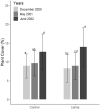Llamas (Llama glama) enhance proglacial ecosystem development in Cordillera Blanca, Peru
- PMID: 37743358
- PMCID: PMC10518316
- DOI: 10.1038/s41598-023-41458-x
Llamas (Llama glama) enhance proglacial ecosystem development in Cordillera Blanca, Peru
Abstract
Worldwide, mountain glaciers are shrinking rapidly. Consequently, large areas are becoming available for the development of novel alpine ecosystems. These harsh environments, however, delay primary succession. In this study with a local community, we conducted an inclusion experiment to investigate whether Llama glama influences soils and vegetation primary succession following glacial retreat. At the foot of the Uruashraju glacier in the Cordillera Blanca, Peru (~ 4680 m.a.s.l.), we established four llama inclusion plots and four control plots that we studied from 2019 to 2022, 24-40 years after deglacierization. After three years, the llama plots had significantly increased soil organic carbon and soil nitrogen. In the llama plots, we found a large, significant increase in vascular plant cover (+ 57%) between the second and third years of experimentation, and we identified four new species that were not present in 2019. Our results suggest that Llama glama, through their latrine behavior and role as a seed disperser, enhances the primary succession and novel ecosystem formation in recently deglacierized landscapes. Our study provides scientific support that rewilding of native Andean camelids may favor adaptation to glacier retreat and inform conservation and management strategies in proglacial landscapes.
© 2023. Springer Nature Limited.
Conflict of interest statement
The authors declare no competing interests.
Figures






References
-
- Rounce DR, et al. Global glacier change in the 21st century: Every increase in temperature matters. Science (80-). 2023;379:78–83. - PubMed
-
- Matthews, J. A. The ecology of recently-deglaciated terrain: a geoecological approach to glacier forelands. (1992).
-
- Cauvy-Fraunié S, Dangles O. A global synthesis of biodiversity responses to glacier retreat. Nat. Ecol. Evol. 2019;3:1675–1685. - PubMed
-
- Ficetola GF, et al. Dynamics of ecological communities following current retreat of glaciers. Annu. Rev. Ecol. Evol. Syst. 2021;52:405–426.
-
- Zimmer A, et al. Time lag between glacial retreat and upward migration alters tropical alpine communities. Perspect. Plant Ecol. Evol. Syst. 2018;30:89–102.
Publication types
MeSH terms
Substances
LinkOut - more resources
Full Text Sources

